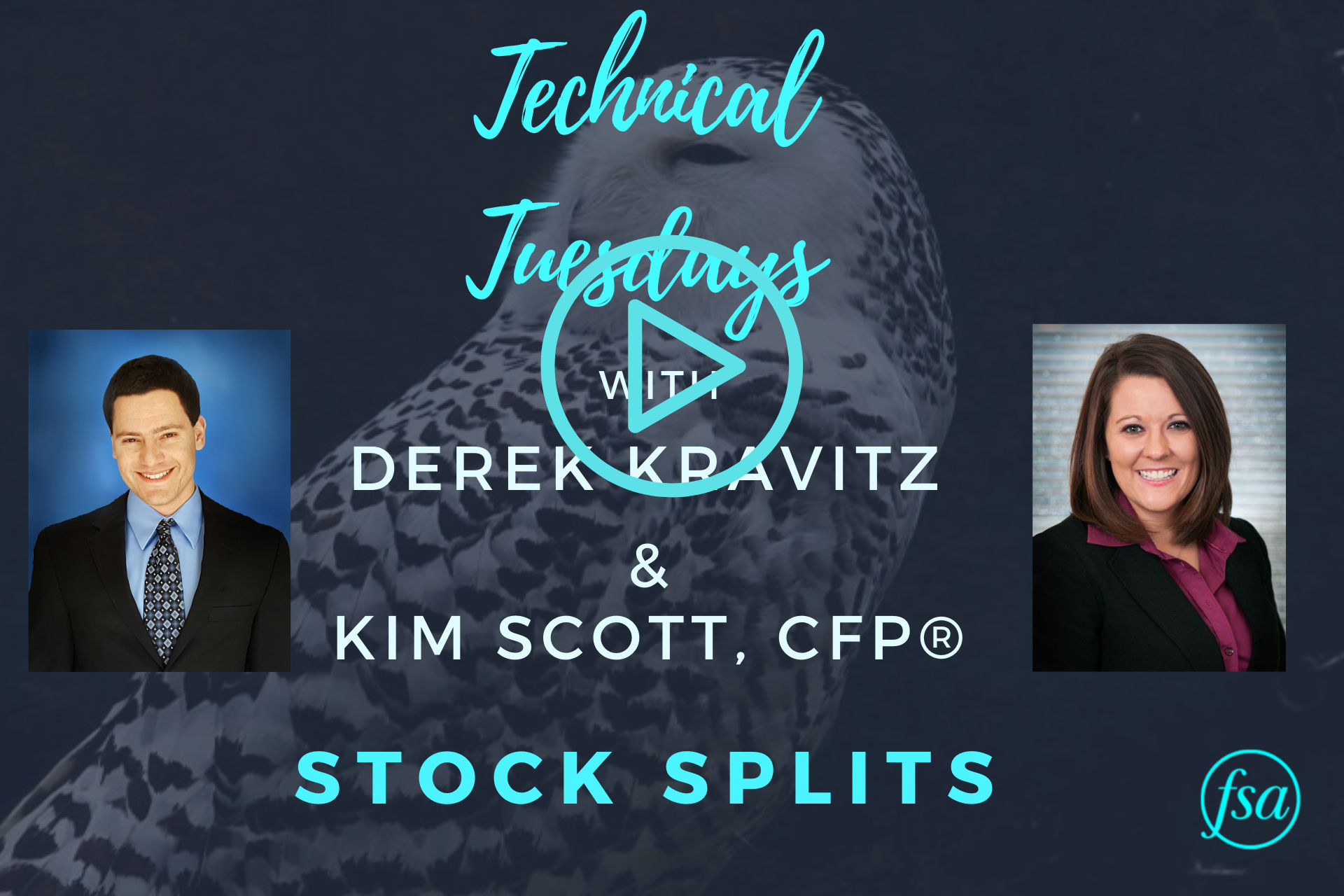Kim Scott and Derek Kravitz discuss what a stock split is and what it does, as well as share some recent examples.
STOCK SPLITS TRANSCRIPT
Kim:
Hey, everyone. Welcome to another Technical Tuesday with Kim and Derek. Derek, how are you doing today?
Derek:
I’m doing great, Kim. Thanks for asking. How are you doing?
Kim:
I am great. I actually, since our last video, have adopted a new puppy.
Derek:
Oh, that’s awesome. Congratulations. What’s his name?
Kim:
Thanks. His name is Cooper, and he is as cute as he is energetic. He’s amazing.
Derek:
That is so cool. Congrats.
Kim:
Thank you. Well, onto our topic today. We’ve had a number of big companies this year undergo stock splits, which have kind of added to a flurry of retail trading activity. So, Derek, I thought this would be a great topic for us to kind of pick your brain today. So, why don’t we start off with you just telling us what is a stock split and how might it affect the company as well as the stock?
Derek:
Yeah, Kim, I’m really glad that you asked that question. I’ve been looking forward to doing this Technical Tuesday video because I think that there is a general misunderstanding in some parts of the investment public about what a stock split is and what it does. In a nutshell, a stock split is a way for a public company to alter the quoted price of their shares in the market without altering any of the fundamentals of the company. So this happens without the company buying back their own shares or issuing new shares. Basically, as the name indicates, a share is split into more shares on a ratio basis.
So, for example, this past summer, we had Apple split its shares into four new shares. So, you had, prior to the split, Apple trading at, say, $400 a share. Post-split, now it’s trading at $100 a share, roughly speaking. There’s market fluctuations, but that’s basically what the end result was. And this, again, has no impact on the underlying value of the company. The fundamentals don’t change. It’s not like they’re going to sell any more or less products because of this. This is just a way for the company itself to change the price that you see when you pull up the ticker online or on your stock trading apps or anything like that.
And this can also work in reverse as well. You can sometimes have companies that decide, “Hey, our stock price, we’d like it to be higher.” And so, they can actually do what’s called a reverse split. They can take, let’s say, two shares and combine them into one new share, and the quoted price would double. Again, it’s not like you double your money when this happens or anything like that. It’s just a tool that the company has readily available to them to alter the quoted price of their shares in the marketplace.
Kim:
Sure. That’s helpful. And I feel like you’ve already alluded to it, but can you tell us more about why a company would want to do a stock split?
Derek:
Yeah, it’s a great question. And there’s a couple of theories out there. The first is that it’s all psychological. So, going back all the way to the 1800s, companies often kept or tried to keep their stock prices around $100 a share. It was just kind of a nice round number.
And I think that companies understand that there’s an investor psychology out there that if the price of their shares goes up to a point where you pull up a quoted price and it’s like, “Wow, that’s a huge number; that’s too expensive for me. It’s too rich for my taste. I can’t afford that.” Whatever the investor might be thinking, the company is trying to combat that. They’re trying to say, “Well, more investors will buy our shares if the price is a lot lower.” Again, this has nothing to do with the fundamental value of the company. But, I think the boards of directors and management of these companies understand and know that there is a psychological aspect out there.
Now, the second theory is, and this is kind of what they would state publicly, and most often you see what they say publicly, is that they would like their investor base to be broader or they would like their shares to be accessible to a broader base of investors.
So, if we take the case of Tesla, this past summer of 2020, for example. It was trading as high as $2,000 pre-split. They decided to split their shares, a single share into five new shares. So, they might say, “Well, our rationale is that we would like our shares to be more accessible to smaller investors.” And prior, when a retail investor might say, “$2,000 is kind of why I don’t really want to buy it for such a high price.” But, if they split it into five new shares and now the price is $400, that same retail investor might think, “Well, now I can afford it.”
And also there’s a portfolio construction aspect to this. I mean, maybe $2,000 is too much to have in a potentially speculative investment, whereas $400 might work. Or in the case of Apple, it went from $400 to $100 and maybe now $100 works in terms of keeping your risk allocation within balance.
So, that’s kind of the reason that you’re going to see a lot of companies say that. I think that’s up for debate. I think the big driving reason is psychological. And I think that companies know and understand the psyche of the investing public. They just want people to buy their shares, so they’re going to do what they can to make that happen, I guess, if that makes sense.
Kim:
Yeah. That makes a lot of sense. One thing that I’ve been finding interesting tracking with some of the stock splits is how the stock has performed after they announce the split but before the split actually happens. There’s actually a CNBC article about that where Apple was up, I think it was about 30%, between the split being announced and when the split happened, and Tesla was up, I think it was 70% which is crazy in my mind. Any thoughts on that?
Derek:
Yeah, it’s truly incredible. And I think that’s part of why I really wanted to do this Technical Tuesday video was because I’m trying to do my part to at least inform investors in my orbit, at least, that when a company announces a stock split, it’s not like they announced that they’re going to be able to do teleportation. It’s just a tool that management uses to adjust the share price of their stock, and no fundamental value is going to be added or diminished because of this. And I just want to get that, if there’s one point that I want to drive home, it’s that, it’s purely aesthetic.
As for some of these names, of course, we’re not issuing buy or sell recommendations on any security, but I do think that you see some movement in these names, in part because there’s excitement around a stock split that I couldn’t buy shares before, but now I can. I just want all investors to have all the knowledge that they have before they make an investment so that they can make an informed decision.
Kim:
That’s great. Thanks, Derek.
Derek:
So, at this point, Kim, I guess I would kind of throw the ball back in your court. If you had a client approaching you that wanted to make a speculative investment in any one of these names, regardless of the split or not, how do you coach them on doing that in a responsible manner, I guess? How would you put on a speculative trade in a responsible manner, so that you don’t end up betting the farm, for example?
Kim:
Yeah. Great question. And first and foremost, as Derek already said, we’re not necessarily recommending any specific stocks. But, this is a question I get a lot from clients where it’s natural to have a company that you believe strongly in or you feel confident that their stock is going to perform well and you want to invest the money in it. And I just want to list a couple things to kind of keep in mind.
First off, at least from our perspective, I would see this as more, we call it, kind of, play money because you’re investing in individual stocks, so it’s more of a risky investment versus your general savings. When you’re saving towards retirement, saving towards short-term goals, like maybe buying a house or a larger purchase, that money should be earmarked a little bit differently. So, first off, I would say, having a separate account, keeping this money separate, so that you know I have these goals that I’m saving for on this side that are retirement, short-term goals, and so forth, and I can invest those more diversified. And then, I can have a separate pool of money that I’m investing in these more speculative investments that I’m kind of intrigued by or feel confident in.
And then, also I would keep in mind the size of the difference, so how much to have in that play account. Again, you want to make sure that you’re set up to be saving into those other buckets and having those set up and having the money you need set aside for your emergency fund and for short-term goals before having money into this play account. So this account should be smaller in size compared to kind of what you’re saving over on the kind of goals side of things. And I would say it’s different for everyone, and so this is a common conversation we have with clients. So if anyone has specific questions, we’re happy to talk through your situation to kind of see what makes sense for you.
Derek:
Thanks, Kim. I think that makes a lot of sense. And I’ll just say anecdotally, from my own personal experience, I’ve found what works is to have a completely separate account as you had mentioned. I think in our first episode, I talked about how I did have some successes in my first foray into trading but that was quickly followed by substantial losses, and I like to think I’m young. I was younger then. I had a while to recoup any of those losses, and I consider them more educational than anything at this point.
But I think those are really good points, is position sizing and making sure that you’re not going to not be able to buy that house or retire if something goes sideways on you, so that makes a lot of sense to me. Thank you.
Kim:
Yeah. And Derek, thank you. Thanks for all of the information you provided today. And as I said earlier to our viewers, if you guys have any additional questions or want to kind of ask about your situation specifically, feel free to reach out to us at Questions@FSAinvest.com.
FSA’s current written Disclosure Brochure and Privacy Notice discussing our current advisory services and fees is available at www.FSAinvest.com/disclosures or by calling 301-949-7300.




